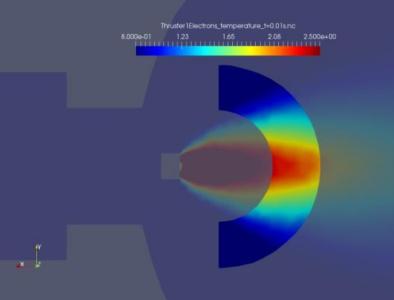Model and experimental validation of spacecraft-thruster interactions (erosion) for electric propulsion thrusters plumes

This study has the following goals: ? To identify and master the key physical processes governing electron cooling and electric field build-up downstream the thruster in the far field and around the satellite surfaces with their own potentials. ? To propose models of electron cooling that, on the one hand, are physically consistent and, on the other hand, are simple enough to be implemented in SPIS without incrementing much the computational requirements. The most suitable case would be a law involving electron temperature and electric potential only. ? To implement these electron models in SPIS ? To experimentally validate on-ground those models using a typical EP thruster used on Telecom platform. ? With the data obtained and the models implemented, to perform system applications including erosion analyses.
Use of electric propulsion (EP) is becoming a key issue for the European industry in order to remain competitive in the short to long term on the space satellites market. One of the main constraints for accommodation of electric thrusters and therefore for architecture choice is the erosion induced by the plasma plumes on satellite surfaces, some of which are very sensitive like solar array interconnectors or antenna layers. Also, eroded parts contaminate other satellite surfaces and equipment. Some of the new architectures under study are exotic compared to the platforms already used and appear to be extremely challenging from the point of view of erosion. Erosion this needs to be assessed as accurately as possible because it will have direct impact on the choice of future architectures and consequently on competitiveness of European satellites.Currently, plume induced erosion on satellites is estimated through simulations with plume models which are necessarily simplified due to industrial and computation constraints. For a given surface material and ion type, the level of erosion caused by one ion depends on the ion energy and incident angle. Those two, when reaching the surface are heavily influenced by the electric field path the ion has followed form the thruster to the surface: simulations shall thus reproduce the electric field map as realistically as possible.The contribution of the experts in solar generators, materials, thermal systems and payload specialists will be welcome during the preparation of the activity. This activity has a multi discipline aspect that could be integrated in the creation of a mini-project on the subject.It is proposed to develop and have access to plasma models usable in day-to-day industrial processes which are able to reproduce with sufficient accuracy the electric field build-up and potential decay downstream the thruster and around the satellite. An experimental validation of those models is mandatory to gain confidence of their adequateTasks:? To perform a state-of-the art literature research on erosion data available. ? To identify and master the key physical processes governing electron cooling and electric field build-up downstream the thruster in the far field and around the satellite surfaces with their own potentials. ? To propose models of electron cooling that, on the one hand, are physically consistent and, on the other hand, are simple enough to be implemented in SPIS without incrementing much the computational requirements. The most suitable case would be a law involving electron temperature and electric potential only. ? To experimentally validate in a vacuum facility those models using a typical EP thruster used on Telecom platform. Plasma plume parameters (ion and electrons characteristics) in the plume far field shall be measured.? With the data obtained and the models implemented in SPIS, to perform system applications including erosion analyses.? To validate erosion of solar cells, thermal blankets, optic instruments etc. that can be affected by the use of EP in a satellite
